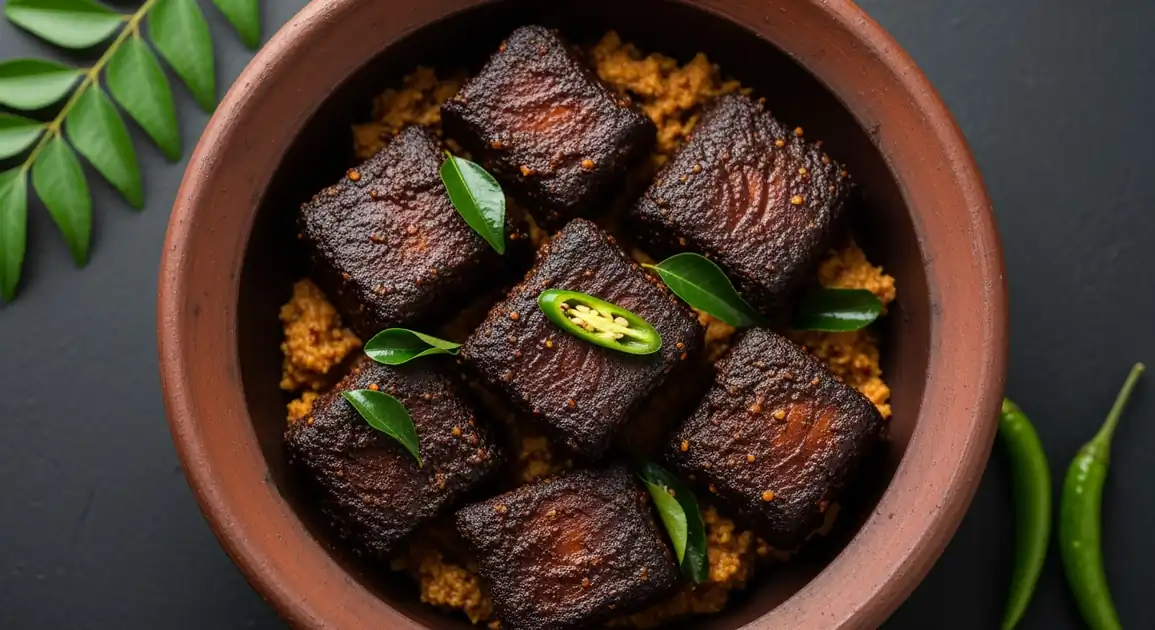Ambulthiyal (Sour Fish Curry)
අම්බුල් තියල්

Description
In Colombo, Sri Lanka's cosmopolitan capital, Ambulthiyal has evolved from its southern roots to become a staple in traditional restaurants throughout the city. While historically not a Colombo dish, the city now offers some excellent versions, ranging from authentic preparations in southern Sri Lankan specialty restaurants to upscale interpretations in fine dining establishments.
Dietary Information
Serving information
Serving style
In Colombo, often served in small clay pots in traditional restaurants or artfully plated in upscale establishments. Always part of a larger rice and curry meal rather than as a standalone dish.
Quick facts
Most restaurants serve lunch from 12 PM - 3 PM and dinner from 7 PM - 10 PM. Some casual eateries may operate continuously throughout the day from 10 AM - 10 PM.
Safety Tips
What to Look For
-
Firm fish pieces that hold their shape
Quality Ambulthiyal should contain solid pieces of fish that flake when pressed but don't disintegrate. Mushy texture indicates poor quality fish or improper preparation.
-
Dark reddish-brown to blackish color
The distinctive color comes from proper use of goraka. Too light a color may indicate insufficient goraka, affecting both flavor and preservative qualities.
-
Fresh, clean aroma with sour notes
Should smell distinctly sour and spiced but not fishy or ammonia-like. The sour smell of goraka is natural, but any off or excessively fishy smells indicate problems.
-
Restaurants that prepare it daily
While Ambulthiyal has natural preservative qualities, freshly made versions are best. Ask when it was prepared if uncertain.
What to avoid
-
Very watery sauce or excessive oil floating on top
Properly prepared Ambulthiyal has a thick, reduced sauce that clings to the fish. Excess liquid may indicate hasty preparation or dilution.
-
Fish with soft, mushy texture or strong fishy smell
These are signs of old or poor quality fish. Despite the preservative nature of the dish, it cannot salvage fish that wasn't fresh to begin with.
-
Bright red color (indicates artificial coloring)
Authentic Ambulthiyal has a dark reddish-brown to blackish hue, never bright red. Artificial coloring is unnecessary in traditional preparation.
-
Version with coconut milk
Traditional Ambulthiyal never contains coconut milk. While not a safety concern, this indicates a non-authentic preparation.
Price information
Price range
Budget tips
- Local eateries in Pettah and Slave Island areas offer more affordable versions (700-1000 LKR).
- Upscale restaurants in Colombo 7 charge premium prices (1500-3000 LKR) for the same dish.
- Hotel restaurants typically charge the highest prices but may adapt spice levels for international guests.
- The Good Market occasionally features vendors selling traditional dishes at moderate prices.
Value indicators
- Generous portion of quality tuna (not small fish pieces).
- Balanced sour flavor from real goraka (not vinegar substitutes).
- Proper thickness of sauce (not watery).
- Served with quality rice and complementary side dishes.
Where to Find This Dish
Fort and Pettah
The historic center has several old-school eateries serving traditional Sri Lankan fare including Ambulthiyal.
Dutch Hospital Shopping Precinct, Pettah Market, Main Street
Lunch (11 AM - 2 PM)
Colombo 7 (Cinnamon Gardens)
Upscale area with refined Sri Lankan restaurants offering quality Ambulthiyal.
Independence Square, Viharamahadevi Park, Colombo National Museum
Lunch, Dinner
Mount Lavinia
This southern suburb has seafood restaurants with good Ambulthiyal, closer to the dish's southern roots.
Mount Lavinia Beach, Mount Lavinia Hotel
Evening (6 PM - 10 PM)
Vendor Tips
- Ask specifically for traditional-style Ambulthiyal, as some Colombo restaurants may tone down the sourness for international palates.
- Restaurants specializing in southern Sri Lankan cuisine generally offer the most authentic versions.
- Many Colombo establishments prepare Ambulthiyal in small batches - going for lunch increases your chance of getting freshly made curry.
How to Order
Regional Variations
-
Restaurant-Style Ambulthiyal
(හෝටල් අම්බුල් තියල්)
Colombo restaurants often prepare a slightly refined version, with carefully balanced sourness and neat, uniform fish pieces.
-
Gourmet Ambulthiyal
(සුපිරි අම්බුල් තියල්)
Upscale establishments may present deconstructed or modernized versions, sometimes with premium tuna cuts or artistic plating.
Cultural context
History
Ambulthiyal originated in southern coastal Sri Lanka as a practical preservation method for fish in hot tropical weather before refrigeration was common. The name derives from 'ambul' (sour) and 'thiyal' (fish dish), highlighting its defining characteristic. Fishing communities discovered that goraka, a local dried fruit, not only added distinctive flavor but also acted as a natural preservative, allowing fish to keep longer. This technique permitted fishermen to preserve their catch and transport it inland where fish was less available. Over time, this utilitarian preparation evolved into a beloved culinary specialty now found throughout the country.
Local significance
In Colombo, Ambulthiyal represents the integration of regional dishes into the capital's diverse food scene. It bridges traditional cooking methods with contemporary dining.
Eating customs
- In Colombo restaurants, often eaten with a spoon and fork rather than by hand.
- Usually one of several curries ordered alongside rice.
- In upscale establishments, may be served as part of a curated Sri Lankan tasting menu.